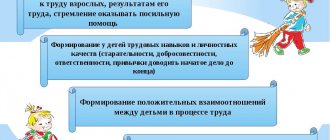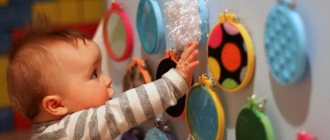The way in which the labor education of preschool children is organized is of great importance. Success in the coming adult life, future practical skills, a responsible attitude to work, a conscious approach to choosing a profession are formed through the joint activities of preschool children and mentors.
Labor education in preschool educational institutions is a means by which:
- basic positive personal qualities and the child’s psychological readiness for adult work are formed;
- pupils develop mental and physical abilities;
- During the lessons, positive, friendly relationships are formed, children get used to working collectively, and learn to appreciate the work of their elders and peers.
Tasks and goals of labor education of preschool children
The labor education of children begins from preschool age, when children copy adults and imitate them with great desire. The main thing is not to miss this moment, to encourage any desire of the child, and also to interest him for further activities. The main goal of labor education of a preschooler is the formation of a reverent attitude towards work, as well as an understanding of adult work.
Main tasks of labor education:
- Show the child how important work is in life, form a correct idea of the work of adults
- Teach the necessary skills for work
- Develop a caring attitude towards work
- Tasks that help develop qualities such as responsibility, hard work, caring
The importance of work for personal development
Many mothers and fathers underestimate child labor, explaining this by the fact that their child will still have time to work at an older age. However, as is already known, labor skills begin to develop from an early age.
Labor activity contributes to the development of endurance, patience, responsibility, willpower, and also develops the child’s independence and desire to achieve certain goals and objectives.
The preschooler begins to realize that work, in addition to joy, can also bring quite a few troubles associated with complex, tedious and boring work.
By helping parents with everyday matters (washing the floor, washing dishes), the child learns to understand that if such work is not done very efficiently and accurately, then it is unlikely that anyone will like it. By running errands for adults, the baby shows love for loved ones.
If you ask a child to fix a toy, this does not mean that you need to resort to any specific mechanical actions. Such work forms the development of initiative, memory, imagination, the child strives to find a way to solve the problem. Also, working with small parts, the child develops fine motor skills, which in turn is very useful for speech and intelligence.
Labor in nature.
In addition to the fact that working with natural objects gives children quite a few positive emotions, work in nature aims to develop observation, curiosity, establish relationships between objects of the ecosystem, and cultivate a careful and caring attitude towards all living things. Labor activity contributes to the acquisition and expansion of knowledge:
- about the soil, its types, methods of caring for it, tools;
- about plants, their structure, stages of growth, developmental features, methods of care;
- about animals, their external characteristics, living conditions, nutrition.
Labor in nature changes at different age stages, its forms and content are different. Children 2-3 years old can participate in watering indoor plants and wipe large leaves with a cloth. You can also involve in planting bulbs or large seeds; for this, prepare a box with soil. The kids, together with their parents, will water and watch the seedlings. If there are animals in the family, then children can feed them, of course, with the help of an adult. At this age stage, parents must remember that all work actions are accompanied by demonstration and explanation and obligatory praise.
They try to independently dose fish food and pour it into the aquarium, and help clean the cage of birds and hamsters. Of course, we should not forget that children’s skills are still far from perfect, so control is necessary so that no harm is caused to living objects. At this age, an adult can evaluate the results of work activity based on quality, which means making comments and asking for mistakes to be corrected.
Older preschoolers independently water and loosen the soil, spray plants, remove dry leaves and flowers, help replant and feed plants, plant seedlings, and plant small seeds. Children of this age can be trusted to feed animals. The task of parents is to control their activities and help in difficult situations.
Forms and types of labor education
Labor education of preschool children in the family helps in physical and moral development. By mastering work skills, children begin to become more confident. Work develops a sense of discipline.
The types of work activities depend on the goals and objectives of the work. By watching adults, children learn work and certain abilities.
Types of labor education
Self-service
This skill must be developed in a child from an early age. But due to the characteristics of a small organism, babies are not yet able to perform various actions: their fingers do not obey, the sequence of actions is not remembered, the inability to control their own will. During this period, adults need to be patient and calm, and be supportive of the baby. This is the only way to get a positive reaction from the child to perform such actions as brushing his own teeth, getting dressed, making the bed, putting away toys.
In order for your child to quickly master self-care skills, you need to:
- Perform these actions constantly
- Monitor the execution of work processes
- Teach your child neatness, cleanliness, neatness
As you get older, add new self-care responsibilities. For example, for a primary school student, work together to prepare school clothes for tomorrow, then allow the child to do it independently, controlling the process.
Household labor
Preschool children need to acquire economic skills. You can entrust your child with simple tasks such as wiping dust, tables, and cleaning toys. In kindergarten, similar work methods apply: while on duty, children set the table, take care of the plants, and wipe the shelves. For every action of the child, it is necessary to praise and encourage him, even if the result of the work performed is not entirely satisfactory. Adults control all actions and, if necessary, correct the child, thereby showing how to properly perform this or that work. It is forbidden to scold children; this is the only way to achieve the goal of labor education.
Labor in nature
Developing working abilities in nature is a great way to experience all the splendor and beauty of the environment, develop skills such as observation and learn to hone your actions. The goal of this type of education is to develop endurance and strong-willed qualities.
Children can be entrusted with feeding birds, fish, and caring for flowers. If the group has a living area, then kids can take care of the animals. At home, children can be assigned the same responsibilities. Another interesting way is to grow greens on the windowsill (onions, dill, parsley). Kids will enjoy watching the growth of such plants and caring for them.
Manual labor
Manual labor means working with your hands. Preschool children make crafts using various materials. Manual labor contributes to the development of such qualities as patience, perseverance, and aesthetic taste. Here, as in any other type of work activity, it is important for the child to receive praise from adults in order to maintain interest in this activity.
Forms of labor education
There are three main forms of labor education:
- Errands. These are individual tasks that are assigned to the child by parents or kindergarten teachers. Here the characteristics of the baby and his experience are taken into account. By completing tasks, the child develops a sense of responsibility.
- Duty roster. This form of work activity is aimed at ensuring that the child completes tasks to serve the team (for example, setting the table). This teaches the child to care about others and to be responsible to the team.
- Teamwork. This form of work is more typical for older children: adults give a general task that must be completed within a certain period of time. Children learn to work in a team and negotiate.
Household work.
This type of work - an integral part of everyday life - consists of creating cleanliness and order in the room, providing all possible assistance to adults. Children of 2 years are just beginning to get acquainted with this type of work activity, watching adults and older brothers and sisters, but already at this age they need to be involved in carrying out simple tasks. This can be expressed in helping to set the table, cleaning up games and toys, laying out or arranging some things or objects in their places, cleaning up dry leaves in the yard, etc. It is important for adults to appreciate the efforts of the child, thereby expressing their love for the baby .
The content of household work for children aged 4-5 years is significantly expanding and becoming more complex. Thus, in families and kindergartens, preschoolers are able to independently wash toys, set the table, put away dishes, prepare a workplace for classes, and then clean it up; with the participation of an adult, they wash doll clothes, wipe dust on furniture and window sills, make the bed, on the street they can sweep the paths, clear the benches of snow, etc.
The household work of older preschoolers is even more varied, complicated and becomes systematic. Children can organize it themselves, select the necessary equipment, evaluate the results, and clean up after themselves after games or activities without a reminder. Of course, modern life is directly related to household appliances; almost every family uses a washing machine, vacuum cleaner, microwave oven, etc. At this age, you can teach preschoolers to use some household appliances, but only under the supervision of their parents.
Methods and means of labor education
From an early age, children learn about the world around them, and the goal of parents is to help with this by teaching simple independent actions.
Labor education of young children is carried out using the following means:
- Own activities. With the help of this tool, kids learn and acquire certain skills, achieve goals and get results. They also develop hard work and discipline.
- Familiarization with the work of adults. This tool helps the child learn about the work activities of other people, about social significance, and forms the right attitude towards work.
- Artistic media. This includes various types of art: music, painting, etc. Of course, you cannot learn to work by listening to a fairy tale or music. However, this helps to interest the child. In most stories and fairy tales, the main characters are always hardworking, help those in need, and ultimately receive love and recognition. A child can experience emotions that make him want to be like someone who does work and is not afraid of work.
The main methods of labor education for preschool children include:
- Emotional mood method: use of musical works, discussion of work activities and results
- Verbal method: discussions, reasoning about the progress of work, methods of its implementation, evaluation
- Visualization method: the nuances of work are shown and demonstrated
- Practical tasks are work that is performed directly by the child himself.
“Types of labor of preschool children and forms of its organization”
“Types of labor of preschool children and forms of its organization.”
Content
1. The importance of labor education in the development of the personality of a preschool child 2
2. Types of work of preschool children, their characteristics 5
3. Place of work during the day 11
4. Working conditions for preschool children 13
5. References 16
1. The importance of labor education in the development of the personality of a preschool child
.
Labor education is one of the most important aspects of raising the younger generation. In kindergarten, labor education consists of familiarizing children with the work of adults and introducing children to the work activities available to them. In the process of introducing adults to the work, the teacher forms in children a positive attitude towards their work, a caring attitude towards its results, and a desire to provide adults with all possible help. By including children in work activities, the teacher develops work skills, develops the habit of work effort, responsibility, caring, thrift, hard work, willingness to participate in work, without avoiding unpleasant work, and forms positive relationships between children.
The organization of child labor must take into account the age and individual characteristics of children and the patterns of their development. In the process of labor, aesthetic and physical education is carried out.
The educational value of self-care is aimed at meeting the child’s daily personal needs. Daily fulfillment of basic work tasks accustoms children to systematic work. Children begin to understand that everyone has work responsibilities related to their daily needs.
Self-care is associated with simple operations, which makes it easier to perform the actions of washing and dressing.
With a properly organized pedagogical process, the daily routine of self-care work creates, in comparison with all other types of work, the most favorable conditions for the child to actively learn the necessary skills and gain practical experience of independent behavior. This is one of the reasons for the use of this type of work to a greater extent in the younger groups of kindergarten.
In self-care, a child is always given a specific goal, the achievement of which is understandable to the child and vitally important for him. The result that he achieves in self-care is clear and opens up for him certain prospects for further activity: he gets dressed - he can go for a walk, put away his toys - he can sit down to study. While serving himself, the child exhibits certain physical and mental efforts.
For a 3-year-old child, each of these processes is attractive, as it provides an opportunity to show independence, satisfies his need for activity and acts as a task that must be solved himself: putting on tights and boots, fastening buttons on a coat. Performing these actions, the child strains his willpower, all his attention is absorbed in this process.
In the process of work, children practically learn the properties of surrounding things, observe the growth and changes of plants, examine animals, and get acquainted with their living conditions. They compare, contrast, and strive to independently find the answer to endless “whys.” They develop curiosity and cognitive interests. Work becomes an important means of children's mental development.
Labor strengthens children physically, since they perform many types of work outdoors: digging a garden bed, fetching water, shoveling snow. Children become capable of exerting their strength and overcoming difficulties.
Labor activity is of particular importance for the formation of moral qualities. By performing simple duties related to setting the table and helping to prepare everything necessary for classes, children learn to be useful to others. This forms in them a willingness to come to the aid of those who need it, willingly carry out feasible work assignments, forms a responsible attitude towards the assigned work, diligence and diligence.
Preschool pedagogy identifies the following main tasks of labor education for children: familiarization with the work of adults and instilling respect for it; training in simple labor skills; nurturing interest in work, hard work and independence; nurturing socially oriented motives for work, the ability to work in a team and for a team. In kindergarten, in the family, in the public environment available to him - everywhere the child encounters the work of adults and takes advantage of its results. At first, children's attention is attracted only by external aspects: the process of labor actions itself, the movement of mechanisms and machines. Consistently familiarizing children with the work of adults in their immediate environment, and then outside the kindergarten, allows them to form an idea of the essence and significance of labor actions, to explain, using specific examples, the attitude of adults to work and its social significance. The teacher tells the children what a hardworking person should be like (he works diligently, gets the job done), what it means to work well, to take care of others, reads to them works about work, in which its meaning and beauty are vividly and emotionally revealed. By instilling in children respect for the working person and the desire to be like him, the teacher instills in them a caring attitude towards the results of their work. It is necessary to remember that work should bring children joy: from the results achieved, from their usefulness to others.
2. Types of work of preschool children, their characteristics
.
Main types of labor
in kindergarten - this is self-service, household work, work in nature, manual labor, and the forms of its organization are assignments, duty and collective work of children.
Self service –
The main feature of this type of work is its focus on oneself. The content of self-service is the ability to serve oneself. Social significance - the child frees others from serving himself. In the process of self-service, the child masters all components of work activity and becomes independent, satisfies his need for activity, accumulates knowledge about subjects, and gets accustomed to work effort.
In early preschool age, self-care is associated with certain difficulties (insufficient development of finger muscles, difficulty in mastering a sequence of actions, inability to plan them, easy distractibility), which slows down the process of skill formation and sometimes makes the child unwilling to perform the necessary actions. However, already in these children, the teacher begins to develop the ability to serve themselves, achieving accuracy and thoroughness in performing the necessary actions, independence, and forms the habit of cleanliness and tidiness. All this requires patience, perseverance and goodwill from him, supporting the kids in their sometimes futile efforts. When guiding children’s self-care, the teacher communicates individually with each child, establishes various contacts with him, and maintains his positive emotional state. By naming items of clothing and its parts, necessary actions, he expands the children's vocabulary. They feel cared for and imbued with a sense of love and trust in the adults serving them.
In middle preschool age, children are quite independent in self-care, and this type of work becomes their constant responsibility. The complication of educational tasks is expressed in increased requirements for the quality of actions, for organized behavior in the process of self-care, and for the time spent on this. The teacher develops techniques for mutual assistance in children, teaches them how to ask a friend for help, how to provide it, and thank them for the service. In older preschool age, new self-care skills are acquired: making the bed, caring for hair and shoes. The processes associated with it are used to solve more complex educational problems: developing in children the habit of neatness and cleanliness, and behavioral skills when surrounded by peers. The child serves himself while being around others, and therefore he must understand the needs and difficulties of others. The teacher, using specific examples, explains what to do, taking into account the needs of others: step aside in the dressing room to allow someone who has already undressed to pass; when washing, let those on duty go ahead (it is more important for them to wash as quickly as possible in order to begin their duties), do not linger at the tap so that everyone washes on time, ask permission to pass so as not to cause inconvenience to anyone, etc. All this shapes children basic courtesy and respect for others.
Household work -
involves the ability to maintain order in the environment; participation in the organization of everyday processes and educational activities. The peculiarity of this type is its social orientation - meeting the needs of others.
Household work of preschoolers is necessary in the daily life of a kindergarten, although its results are not so noticeable in comparison with other types of their labor activity. This work is aimed at maintaining cleanliness and order in the premises and area, and at helping adults organize routine processes. Children learn to notice any disturbance of order in a group room or area and, on their own initiative, eliminate it. Household work is aimed at serving the team and therefore contains great opportunities for developing a caring attitude towards peers. In early preschool age, the teacher develops basic household skills in children: helping to set the table, tidying up toys after playing and washing them, collecting leaves on the site, sweeping snow from benches. He always evaluates the moral side of the children’s labor participation: “Natasha and Seryozha helped our nanny well, what great fellows!” Such assessments make children want to imitate their peers and contribute to the formation of ideas about how to act in such cases.
In the middle group, the content of household work expands significantly: children fully set the table, prepare everything necessary for classes, wash doll clothes, sweep paths in the area, etc.
Using their increased capabilities and taking into account the developed skills, the teacher accustoms children to the fact that in work it is necessary to make an effort, develops independence, active initiative in carrying out assigned tasks.
In the older groups of the kindergarten, household work is even more enriched in content and becomes systematic, largely turning into the permanent duties of those on duty. Children keep the room and area clean, repair toys and books, and provide assistance to children. The peculiarity of the household work of older preschoolers is the ability to organize it independently: select the necessary equipment, place it conveniently, put everything in order after work. In the process of work, children show diligence, a desire for a good result, and treat their peers kindly.
Labor in nature -
requires children to have a certain range of knowledge about the life of plants and animals, the ability to control their actions, and a certain level of responsibility. This type of work is characterized by the fact that, on the one hand, it is aimed at meeting the needs of children and the group as a whole, and on the other, at protecting nature.
Labor in nature involves the participation of children in caring for plants and animals, growing plants in a corner of nature, in a vegetable garden, in a flower garden. This type of work is of particular importance for the development of observation, nurturing a caring attitude towards all living things, and love for one’s native nature. It helps the teacher solve the problems of children’s physical development, improving movements, increasing endurance, and developing the ability for physical effort.
In younger groups, children, with the help of adults, feed fish, water and wash indoor plants, plant bulbs, sow large seeds, take part in harvesting from their garden, and feed wintering birds. Supervising the work of the children, the teacher names the plants, their parts, and the actions performed in the work; this expands children's vocabulary and activates it.
Children look at the plants: “Show where the leaves are small and where they are large,” “Count how many flowers have bloomed.” The teacher explains the need to care for plants and animals.
In the middle group, work becomes more difficult. Children water the plants themselves, learn to determine the need for moisture, grow vegetables (sow seeds, water the beds, harvest), and with the help of the teacher prepare food for animals. The process of caring for animals is closely connected with observations of them. Children begin to realize the dependence of the growth and development of plants and animal behavior on the quality of care, and their responsibility for them. There is growing concern and attention to the inhabitants of the living corner, who become children's favorites.
For the older group, plants and animals that require more complex care techniques are placed in a corner of nature; various types of vegetables with different growing seasons are planted in the garden, which makes the work more systematic.
The volume of child labor is also increasing. Preschoolers spray plants with a spray bottle, sweep away dust from fuzzy leaves with a brush, and loosen the ground. With the help of the teacher, children feed the plants, recharge the aquarium, dig up the soil in the vegetable garden and flower garden, plant seedlings, and collect seeds of wild plants (to feed wintering birds). In the process of work, the teacher teaches children to observe the growth and development of plants, to note changes that occur, to distinguish plants by their characteristic features, leaves, and seeds. This expands their understanding of the life of plants and animals and arouses keen interest in them.
In the preparatory group, in the process of working in nature, children learn to establish connections between individual phenomena and discover patterns. The beginnings of a materialistic understanding of natural phenomena are being formed. Information about plants and animals and methods of caring for the inhabitants of a living area is expanding. Children’s independence in work matters increases: without being reminded, they determine the need for watering and loosening the soil, replanting plants, sowing seeds in the garden, in the flower garden, and in winter in a corner of nature where onions and other greens are constantly grown. Children will learn techniques for propagating plants by cuttings, growing seedlings and then replanting them in the ground. Children become more responsible for the condition of the living area, vegetable garden and flower garden.
Manual labor -
appears in the senior group (making attributes, gifts, etc.). Requires the ability to use scissors, a needle, and knowledge of materials. This type of work is closest in terms of results and use of tools to the social work of adults. This activity develops the child's constructive and planning thinking.
Manual labor - the production of objects from a variety of materials: cardboard, paper, wood, natural materials (cones, acorns, straw, bark, corn cobs, peach pits), waste material (reels, boxes) using fur, feathers, fabric scraps is carried out in senior groups of kindergarten. Children make the toys they need and attributes for games: boats, cars, baskets, houses, furniture, animals. Such crafts can be a pleasant gift for family and friends. This is of no small importance in moral education, teaching children to pay attention to others and to work hard in order to please them.
Manual labor develops children's constructive abilities, creativity, and imagination. In the process of work, they become familiar with the properties of various materials, methods of processing and joining them, and learn to use various tools. The child needs to show persistence, patience, and accuracy in order for the object to be durable and have a neat, elegant appearance. All this has a great educational impact on children, shaping their aesthetic feelings and moral and volitional qualities.
3. Place of work during the day.
For the rational organization of work activities in groups, it is necessary to create conditions. Determine where equipment will be stored.
Self-service -
Self-care activities are present in all routine moments (hygiene procedures - hand washing, washing, using napkins and handkerchiefs).
Household labor
— various forms of organization are possible: frontal (collective work), subgroup (on duty), individual (assignments).
-Duties are carried out according to the scheduled moment (before classes, after classes, before and after meals);
—
Instructions are given to children throughout the day while performing routine processes;
—
Collective work is organized when cleaning the premises (group room, locker room) - carried out in the afternoon; when cleaning the area during walks in the first and second half of the day.
Labor in nature
- organized in the form of assignments, duty (in a corner of nature), collective work (in the kindergarten area). Duties in a corner of nature, in a group, are carried out in the morning, before breakfast, at the same time assignments related to work in nature are carried out. During the walk, collective and individual work in nature is organized: caring for plants and birds.
Manual labor -
from senior preschool age. Manual labor classes are held in the first half of the day (according to the schedule of classes), individual work and free activities of children in manual labor are organized in the afternoon.
Children are involved in work activities throughout their entire stay in kindergarten. And in order to develop a positive attitude towards work in preschoolers, it is necessary to clearly plan their work activities (duty schedule, plan for collective work activities, plan for individual work with children).
Proper organization of the subject-development environment is also necessary:
—
Duty Officers' Corner
-
here should be all the necessary attributes of duty officers (aprons, scarves, brooms and dustpans, cloths for tables - for dining duty; aprons, scarves, cloths, watering cans, spray bottles, shovels for loosening the earth, etc. - for duty in a corner of nature; necessary materials for those on duty for classes).
—
To work on the site, you need gardening tools, gloves, robes or aprons, etc.
Only correctly and rationally organized and positive labor activity will give positive results and develop labor skills in preschoolers, and, therefore, will contribute to labor education.
4.
Working conditions.
The implementation of the tasks of labor education of a preschooler, provided for by the “Kindergarten Teacher Program,” is possible only if there are conditions under which labor becomes a means of pedagogical influence on children. What are these conditions?
—
Systematic inclusion of every child in labor.
The teacher organizes the work of children in three main forms: in the form of assignments, individual and collective, duties and collective work activities, in which all children in the group simultaneously participate.
In junior and middle groups, assignments are used to the greatest extent; in older groups, work is increasingly acquiring a collective character.
Self-care work becomes a daily responsibility for older preschoolers. Manual labor will be systematic if it is planned weekly and organized in the form of general orders. Thus, by participating in one or another type of labor, preschoolers get the opportunity to work every day.
— The following conditions take into account the load on the child.
In work, the child faces a load; work as an activity is always accompanied by the application of effort. The greatest importance in work is the formation of moral qualities of the individual. And the formation of correct ideas about work is only possible if the work offered to children is associated with overcoming effort. Insufficient load leads to the fact that the child easily copes with the proposed task, does not feel the effort, he gets used to working without stress. And when it is necessary to complete a more complex task, the child cannot calculate his strength. He leaves the work unfinished, and loses interest in it when faced with the slightest difficulties.
At the same time, too much load should not be allowed. Overload in work causes children to quickly become tired, and therefore they develop a negative attitude towards work, they refuse to complete the task to the end or re-engage in work after a while. Consequently, the workload is directly related to the formation of a positive attitude towards it.
In order to prevent a negative attitude towards work, children should be offered work that they can cope with, expending sufficient effort, but without overworking. The teacher needs to observe the children’s activities, noting the onset of fatigue, which leads to a decrease in interest, a slowdown in the pace of activity, and in especially stressful types of work - redness of the face, sweating, and rapid breathing. Organization of children’s work in the area, for example, snow removal; the teacher must organize children’s work so that several children participate in it. At the same time, it becomes possible to change the nature of the work, for example, one person first shovels the snow, others put it on a sled, and still others take it to the construction site. After 8-10 minutes, the children change places. This is called giving rest to those who shoveled the snow, changing the activities of everyone, which serves as some kind of rest.
—
Selection of equipment for work
.
The availability of convenient equipment for work is of no small importance. Well-chosen equipment that has an attractive appearance allows the child to complete the task carefully, motivates him to work, and makes him want to work. Equipment must be placed so that it is convenient for children to pick it up, use it, put it in order and put it in place. Children should know what and where it is so that they can independently use the equipment, clean or wipe it after work. Then, in the process of mastering labor skills, the skill of using and caring for objects of labor will be acquired at the same time.
— Of no small importance in the labor education of children is the creation of a working atmosphere in the group:
After finishing the game, put away your toys, prepare your bed for bed every day, neatly fold your clothes, and tidy up your appearance. All this requires work effort from the child, and constant attention from the teacher to how carefully and timely the children complete all these tasks. If a constant order is established in the group, then in such conditions it is easier to replace any violation of it and children do not have to be reminded or prompted; they easily develop the correct skill, respect for the rule: “Every thing has its place.” The teacher should constantly remember his role as a group leader. When taking on any task, he certainly organizes the children to complete it. In this way, he creates in the group an atmosphere of constant employment, a constant desire for useful things.
Bibliography
.
1. Bure R.S., Ostrovskaya L.F. Teacher and children. – M., 2002.
2. Raising a preschooler at work. / ed. V. D. Nechaeva. – M., 1980.
3. Preschool pedagogy. Textbook a manual for students majoring in “Preschool pedagogy and psychology” / Ed. V. I. Loginova. - M.: Education, 1993.
4. Preschool pedagogy. Textbook manual for pedagogical students. institute "Pedagogy and Psychology" / ed. N. A. Kurochkina, B. S. Leikina, V. I. Loginova and others; Ed. V. I. Loginova, P. G. Samorukova. – 2nd ed., rev. and additional – M.: Education, 1988.
5. Origins: Basic program for the development of a preschool child / T. I. Alieva, T. V. Antonova, E. P. Arnautova and others. Scientific editor. L. A. Paramonova, A. N. Davidchuk, K. V. Tarasova and others - M.: Karapuz, 1997.
Features of labor education in the family
- Parents must set a good example. If mom and dad are constantly arguing about who will go take out the trash or wash the dishes today, then it will be difficult to teach the baby to work hard.
- Labor education should begin from an early age. Typically, children do not like to clean up their toys. In this case, do it together. All toys should have their place: books on the shelf, soft toys in the basket
- If your child wants to do something on his own, don’t interfere. Even if the child didn’t wash the plate well or gets dressed too slowly. Be patient and also assign certain simple responsibilities to your baby.
- Praise your child for anything he does. It is very important for kids to understand that they are great. Parents' admiration is the best reward
- There is no need to force a child to work. The best option is joint work. Turn ordinary cleaning into a game, a competition
- Entrust your baby with regular responsibilities according to his age: feeding pets, caring for flowers. This way the child will understand that his work is very important in the family.
- The child needs to understand the result of his actions. Explain to him why he is doing this or that work: if you don’t feed the fish, they will die, and flowers will wither without water
- Some instructions may not be clear to the child, so adults need to show the child exactly how to do the work. It will probably take some time for the child to understand. Be patient and repeat as many times as necessary
- Monitor your baby. If a child does not do the job well, and the parents then finish it or redo it for him, then in the future the child will shirk from completing assignments, knowing that they will do everything for him anyway
Fostering hard work in young children
To achieve success in life, a person must be hardworking. Nature did not instill such a quality in us, so love for work must be developed. The main task of labor education for preschoolers is to teach hard work and to be responsible for the task being performed.
Labor education of children of primary preschool age begins with self-service, or carrying out simple instructions from parents in everyday life. Older children perform educational and social work. The sooner parents begin to introduce their children to household work, the easier it will be for them to cope with their work responsibilities in the future.
Each child, like any person, has his own specific interests in certain activities. And if you do not pay attention to such interest and desire of the baby, and do not engage in further development, then this interest may disappear altogether. It is important for mom and dad to support the child, as well as add something new that will help develop hard work. Combine business with pleasure in the form of play, and your child’s work will be easy; he will be interested in helping not only himself, but also those around him.
Kids love to imitate adults, it’s important not to miss this moment. Let your baby help you with simple family tasks: putting toys away, wiping the table, washing a cup, and so on. Allow your child to be independent, especially if he wants it himself.
Don't forget about rest, a little person needs it. In between work activities, allow your child to do what he likes.
Labor education of girls
Girls need to be involved in household work: taught to clean the house, do laundry, cook simple meals, and set the table. Such activities should be unobtrusive and properly organized so that the baby becomes more and more willing to help her mother. The daughter needs to understand that they need her help. As you grow older, you need to add more complex tasks: handicrafts, caring for the younger ones.
Working together, mother and daughter develop mutual understanding. In the future, all this will have a positive impact on caring for elderly parents.
Labor education of boys
The best example for a son is his father. If dad sits on the couch all day long and does not help his wife, then most likely the boy will not grow up to be a hard worker.
Depending on the age of the baby, dad can assign various work activities: helping during the repair of any items, giving tools, assisting with work in the garden or garage. A common cause promotes rapprochement and improvement of relationships. Repairing some simple household appliances can be turned into an interesting activity, stimulating the child’s greater interest.
Labor education in relation to different age groups
Preschool age is the best time to develop basic self-care skills, certain skills, and observation. With each stage, the load becomes more complex and requires appropriate actions from the guys. Adults need to remember about age-related characteristics, show patience and kindness, so as not to cause denial in the child.
- The child's fingers are not yet sufficiently developed and do not obey him well.
- The sequence of actions is also not given to the baby; it is difficult to remember everything the first time.
- A younger preschooler will not be able to attract volitional efforts to help; these abilities are still just being formed.
Teachers usually know which teaching methods are appropriate for each age group. They have the responsibility to give recommendations to parents so that children develop harmoniously.
Taking into account the physiological and psychological characteristics of pupils, you need to remember that for children 3-4 years old, the optimal duration of work is 10-15 minutes . Children aged 6-7 years do physical exercise for a maximum of half an hour. The condition of each baby must be monitored. Pay attention to sweating and redness of the skin, when they appear it is better to change your occupation. To prevent children from getting tired, it is better to move on to other activities after 10-15 minutes. When dosing them, be sure to take into account the volume of physical activity and its complexity.
Non-traditional drawing technique for the middle group of kindergarten
Labor education in the younger group
Children 3-4 years old are active, often talking about their desire to participate in one activity or another. But they get tired quickly, it is difficult for them to concentrate, so you should not overload them. The assignments of adults in the younger group are more individual in nature; the student will only need to hang up towels or arrange the cutlery for dinner.
Points to consider:
- labor education is situational in nature, for a three-year-old the main thing is that the tasks are simple and understandable;
- children should be praised for any success;
- In order for the child to understand the meaning of his actions, the teacher needs to explain the tasks and evaluate the results;
- Before doing anything, the child needs to observe how an adult copes with it; then the child’s actions follow with step-by-step comments from the teacher.
The main method of working on labor education with children 3-4 years old is personal example. The guys watch the actions of their elders, manual labor, various exercises are carried out in a playful way. Knowledge is consolidated through the example of such famous works as “Fedorino’s grief” or “Moidodyr”.
Labor education in the middle group
By the age of four, the baby will be able to handle sweeping paths or washing doll clothes. The tasks gradually become more complex, and the children already have some self-organization skills. They can be entrusted with duty in the dining room or preparing for classes; the children are quite capable of performing simple care for animals in a corner of nature.
In the working method it is important:
- note the child’s desire to help;
- the work is carried out in a playful way (application and design, rules of behavior in various situations are reinforced through role-playing games);
- visual aids are used;
- Conversations are held about the content of future actions and relationships.
Labor education in the senior group
Collective assignments are already being used with children aged 5-7 years. When interacting with each other, children learn to coordinate efforts, agree on something, and share responsibilities among themselves. Playing for children is still the main activity, but they meet the teacher halfway, help replace bed linen in the bedroom or collect leaves on the site.
It is important for the teacher to organize the workspace and equipment. Shovels and watering cans should be bright and comfortable to make children want to play with them. Elegant aprons will create a feeling of celebration. The duration of classes should not be overtiring.
?
The main goal of the labor development process in preschool educational institutions is to develop a respectful attitude towards the activities of adults, familiarity with the main professions, understanding of their significance, and the desire to help.
Labor education in the preparatory group
For older preschoolers, work takes on a systematic nature and becomes more numerous. Children repair books or boxes and sew buttons on their own. Under the supervision of the teacher, they prepare the necessary manuals for classes, counting material, and cut out specified elements from plastic bottles. The guys themselves notice the disorder in the area, water the flowers, and remove fallen leaves.
The theme of the week is “Book Week” in the senior and preparatory groups
In the seventh year of life, pupils help set the table for dinner, the attendants monitor the availability of soap and towels, the quality of hand washing, and look after the living area.
Tips for parents
- Try to avoid concepts such as women's and men's responsibilities. There is nothing wrong with a man cleaning the floors or preparing dinner. Any work activity is worthy of respect
- There is no need to overload your child with work. Work must be within reasonable limits for a specific age and individual characteristics. Still, games for kids are the main activity
- From an early age, it is necessary to establish certain rules in the family about what is allowed and what is not allowed. The future family atmosphere in the lives of children will depend on this: lack of discipline, or order
- In order for a child not to grow up as a consumer, labor education is absolutely necessary. If you don’t teach your child to work with others, he will never learn to do something for others.
- Do not use work as a punishment, otherwise your child will develop a negative opinion about work. It is necessary to punish by depriving some kind of joy: watching TV, sweets, pocket money, etc.
- Teach your child to treat any work with care and respect. Talk with your child about your work, about the work of friends and acquaintances
Manual labor.
It helps children obtain primary information about the properties of various materials and how to work with them. Preschoolers should be introduced to this type of work no earlier than 4 years old, because it involves working with different types of paper and fabric, threads, leather, natural and waste materials, dough, plaster, beads, scissors, glue, and awl. Manual labor turns children and parents into creators, as it allows them to show imagination and ingenuity in the manufacture of a beautiful product that can be used as a toy, household item, or gift. There are a great variety of work options: collages, panels, soft toys, napkins, decorative ornaments, small sculptures, etc. In the family, you can organize themed days, for example, “Santa Claus’s Workshop”, “Mom’s Helper”, “Winter Artist”, etc. Manual labor involves joint creativity of parents and child.







